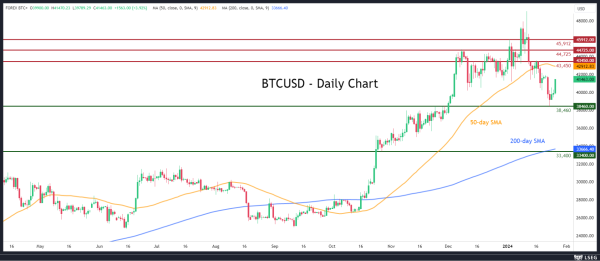Bitcoin post-ETF selloff takes a breather – Crypto News
Bitcoin prices stabilise as selling pressures ease
Tough battle expected around 40,000 psychological mark
Investors digest spot ETF impact on Bitcoin characteristics
On Tuesday, Bitcoin fell to its lowest level since the U.S. Securities and Exchange Commission’s (SEC) approved spot-Bitcoin ETFs, validating the anticipated sell-the-news type of reaction. Following a fresh two-year high of $49,051 in the aftermath of the decision, Bitcoin’s price dropped to as low as $38,460 before rotating back above the $40,000 psychological mark.
As profit taking seems to be abating, Bitcoin’s fate lies in whether spot-ETF inflows can outweigh the remaining selling pressure. Of course, following a more than 160% advance in 2023, there is ample room for profit taking despite the latest retracement. Hence, it is clearly too early to draw conclusions, but for sure traders should not get overly optimistic with the recent rebound.
Don’t forget that cryptocurrencies have also found some love lately from the sustained rally in stock markets, which has pushed all major US equity indices to fresh record highs this week. The prospect of rate cuts by central banks coupled with Bitcoin halving could also prove beneficial for crypto prices moving forward.
What has really changed?Even though the approval of spot-Bitcoin ETFs was cheered by crypto enthusiasts, it clearly contradicts the narrative behind which digitals assets were created in the first place. On the one hand, adoption by big Wall Street names can help with legitimacy, liquidity and attract institutional inflows, but Bitcoin was initially designed to bypass the traditional banking system through peer-to-peer transactions.
With the latest developments, it is highly likely that the volume of Bitcoin trading through the blockchain would be less than that traded via regular stock exchanges. Therefore, by giving away their decentralized attributes cryptocurrencies are set to become more correlated with traditional risk-sensitive assets such as stocks. Should that scenario materialise, it would be difficult to make a case for cryptos against stocks as the latter also entail intrinsic fundamental value.
Is there more downside on cards?BTCUSD experienced a 20% decline from its two-year high of $49,051, falling to as low as $38,460. However, the price quickly bounced back and is exchanging hands around $41,300 at the time of writing.

Should the rebound resume, Bitcoin might test the January resistance of 43,450 ahead of the December peak of $44,725.
On the flipside, if bearish pressures re-emerge, the price slide back below the $40,000 psychological mark towards the January low of $38,460